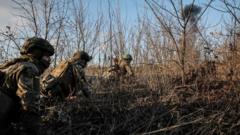As the Biden administration nears the conclusion of a historic alliance-building initiative through military assistance to Ukraine, the recent gatherings at Ramstein Air Base mark a significant moment in international relations and defense strategy.**
U.S. Strategy in Ukraine: A Shift in Alliance Dynamics**

U.S. Strategy in Ukraine: A Shift in Alliance Dynamics**
The U.S. leverages its military support for Ukraine to reshape global alliances amidst the ongoing conflict with Russia.**
In the wake of Russia's invasion of Ukraine in February 2022, the urgency for military supplies became evident as Ukrainian troops struggled with inadequate ammunition for their outdated Soviet-era artillery. Recognizing the limitations of accessing Russian heavy artillery ammunition amid diminishing global stockpiles, the United States swiftly sought alternatives from its network of allies.
A pivotal moment occurred when Defense Secretary Lloyd J. Austin III reached out to Gen. Mark A. Milley, then chairman of the Joint Chiefs of Staff, to coordinate the rapid deployment of American howitzers and high-explosive shells to support Ukraine's defense. This strategic call ignited a robust arms pipeline to Ukraine and marked the beginning of a broader re-evaluation of U.S. alliances in the face of Russian aggression.
The Biden administration initially turned to traditional allies within NATO for support but extended its outreach to non-NATO nations as well, nurturing military relations that have now culminated in a global coalition aimed at bolstering Ukraine’s defensive capabilities. This inclusive approach exemplifies a transformative shift in U.S. foreign policy, one that prioritizes collaboration across diverse military backgrounds to counteract threats posed by Russia.
As the Ukraine Defense Contact Group convenes at Ramstein Air Base for what is anticipated to be the final meeting under the Biden administration, officials reflect on the extensive collaborations and tactical partnerships forged over nearly three years. The outcomes of this coalition not only aim to sustain Ukraine’s resilience in the military theater but also signify a recalibrated blueprint for how the U.S. envisions its alliances in a changing geopolitical landscape.
The conclusion of this vital series of assemblies represents a strategic moment in global cooperation against authoritarianism, promoting stability and defensive alignment in regions previously underappreciated by traditional alliance frameworks. These dynamics will likely continue to evolve in response to ongoing geopolitical challenges, shaping the future of international military assistance and coalition-building efforts.
A pivotal moment occurred when Defense Secretary Lloyd J. Austin III reached out to Gen. Mark A. Milley, then chairman of the Joint Chiefs of Staff, to coordinate the rapid deployment of American howitzers and high-explosive shells to support Ukraine's defense. This strategic call ignited a robust arms pipeline to Ukraine and marked the beginning of a broader re-evaluation of U.S. alliances in the face of Russian aggression.
The Biden administration initially turned to traditional allies within NATO for support but extended its outreach to non-NATO nations as well, nurturing military relations that have now culminated in a global coalition aimed at bolstering Ukraine’s defensive capabilities. This inclusive approach exemplifies a transformative shift in U.S. foreign policy, one that prioritizes collaboration across diverse military backgrounds to counteract threats posed by Russia.
As the Ukraine Defense Contact Group convenes at Ramstein Air Base for what is anticipated to be the final meeting under the Biden administration, officials reflect on the extensive collaborations and tactical partnerships forged over nearly three years. The outcomes of this coalition not only aim to sustain Ukraine’s resilience in the military theater but also signify a recalibrated blueprint for how the U.S. envisions its alliances in a changing geopolitical landscape.
The conclusion of this vital series of assemblies represents a strategic moment in global cooperation against authoritarianism, promoting stability and defensive alignment in regions previously underappreciated by traditional alliance frameworks. These dynamics will likely continue to evolve in response to ongoing geopolitical challenges, shaping the future of international military assistance and coalition-building efforts.




















